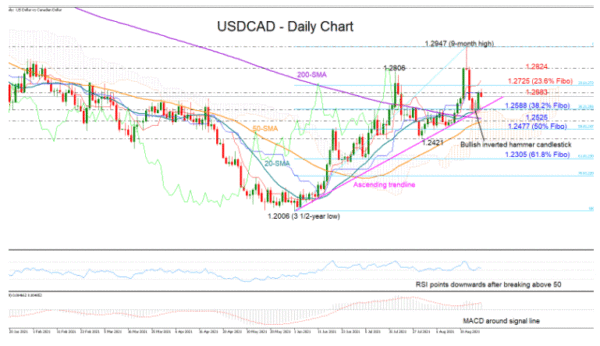USDCAD stepped decisively on the ascending trendline, which has been supporting the market since the drop to a 3 ½-year low of 1.2006 in May, and drifted northwards to hit resistance within the 1.2680 – 1.2700 zone.
The cheerful upside correction in the price was not strong enough to drive the MACD above its red signal line, while the rebound in the RSI seems fragile as the indicator is currently pointing to the downside again. That said, the inverted hammer candlestick which preceded yesterday’s rebound could be a warning that buying pressures may remain in play, even if some weakness occurs.
In trend signals, the fresh bullish cross between the 20- and 200-day simple moving averages (SMAs) raised confidence in the ongoing uptrend, and a potential intersection between the 50- and 200-day SMAs could further boost optimism that the upward trajectory might hold on for longer.
If selling pressures resurface, the ascending trendline may come to the rescue once again, helping the price to find its feet near the 38.2% Fibonacci retracement of the 1.2006 – 1.2947 upleg at 1.2588. This is also where the surface of the Ichimoku cloud is currently positioned. Hence, unless the 1.2525 – 1.2470 territory, which encapsulates the 50- and 200-day SMAs and the 50% Fibonacci, blocks the way down, the price could dive towards its previous low of 1.2421.A step lower would invalidate the upward pattern.
In the bullish scenario, where the pair advances above the 1.2680 – 1.2700 wall, breaking the 23.6% Fibonacci of 1.2725 too, the bulls will push for a close above the tough 1.2824 resistance. If efforts prove successful, the door will open for the nine-month high of 1.2947, where any violation would attract new buying interest, upgrading the positive outlook.
Summarizing, USDCAD is currently holding a neutral-to-bullish bias. A clear close above 1.2725 could confirm additional gains, while a break below 1.2588 could shift the bias to bearish















